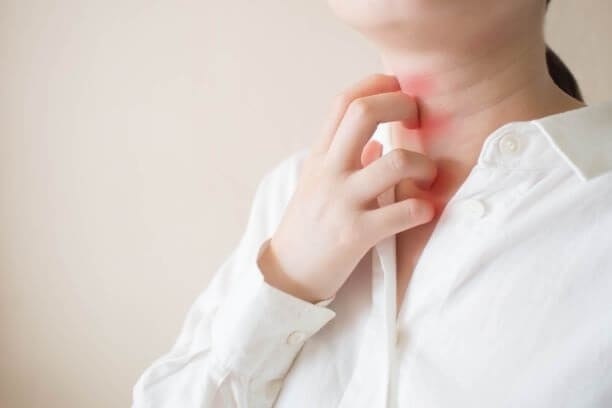With the warm summer months ahead, most of us are looking forward to spending more time outdoors, and dermatologists are getting ready to address all those summertime skin health concerns like sunburns and poison ivy. Heat rash is another common skin concern that increases during the summer. According to Dr. Lauren Snitzer of U.S. Dermatology Partners in Sugar Land, Texas, “Heat rash can happen at any time of the year, but it’s more likely to occur during the warm, humid months in the summer. The good news is, this condition is relatively easily addressed even at home, and if you’re having a tough time with heat rash, your dermatologist can help.” If you have a rash you suspect may be heat rash, you can learn more about how to identify and treat this condition in our blog or by getting in touch with your dermatologist.
What Is Heat Rash?
Dr. Snitzer says, “The role of our skin is to provide a shield to defend the body against allergens, irritants, and other sources of potential danger or damage from the outside world. It also plays an important role in regulating our temperature. Sweat glands, as the name indicates, produce sweat, which is then excreted through ducts or pores in 08the skin. After sweat reaches the surface of our skin, the evaporation process helps to cool our bodies down. Heat rash occurs when the sweat ducts become clogged, leading to inflammation, irritation, and potentially infection.”
Certain types of heat rash may also be referred to as prickly heat, and medically it’s called miliaria. When sweat ducts are blocked, it prevents sweat from reaching the surface of the skin. Instead, the sweat is trapped beneath the skin, causing an uncomfortable rash. Actually, it leads to four different types of rashes known as miliaria crystallina, miliaria rubra, miliaria pustulosa, and miliaria profunda.
Miliaria is a very common skin condition among patients of all ages, but it’s especially common among infants, children, and older adults. You’re also at a greater risk for heat rash if you live in a climate that is often hot and humid. This condition is often caused by:
- Excessive exercise leading to sweating
- Skin rubbing together preventing sweat evaporation
- Wearing tight clothing that doesn’t allow moisture to evaporate
- Using heavy creams, lotions, or cosmetics prior to sweating
- Wearing bandages or braces over sweaty skin
- Working in hot, humid, confined spaces
- Certain medications (including clonidine) may increase the risk for heat rash
What Are the Common Symptoms of Heat Rash?
According to Dr. Snitzer, “Each of the four types of heat rash has a unique appearance and set of symptoms, and some forms of miliaria may be mistaken for other, more serious skin conditions. By knowing what you’re looking for, you’ll have a better chance of correctly identifying and caring for these conditions.”
- Miliaria Crystallina – Also called clear heat rash, this form of miliaria produces a rash that has clear or skin-colored, sweat-filled bumps on the top of the skin that may or may not burst. Typically, this is the mildest form of heat rash. The symptoms usually clear up within a few hours or days of developing, and it’s not as painful or uncomfortable as other forms of miliaria. This is the type of heat rash most often developed by children.
- Miliaria Rubra – Also called red heat rash, is the most common form of miliaria. This form of miliaria is the type most frequently called prickly heat because of the burning itch that accompanies a red-colored rash. Additionally, people with this condition may notice they’re not sweating in the area impacted by miliaria. There may also be inflammation and pain. This is the type of miliaria more often experienced by adults. While it’s more painful than clear heat rash, people with miliaria rubra can still typically address the condition at home.
- Miliaria Pustulosa – Also called white or yellow heat rash, this condition causes pustules to form beneath the skin. This condition occurs as a result of sores or pustules forming during a case of miliaria rubra. Usually, the pustules are indicative of infection, and without treatment, they can be dangerous. The pustules may also be very painful. In most cases, it’s recommended that patients work with a dermatologist to treat this form of heat rash.
- Miliaria profunda – Also known as a deep heat rash, this condition is most common for people who develop chronic or frequent flareups in heat rash. The inflammation, irritation, and infection related to chronic heat rash flareups damages deeper layers of the skin. This can present as larger, firm, skin-colored bumps on the skin that’s exposed to heat. It’s most often triggered by excessive exercise. Because sweating is prevented, people may overheat, which can cause nausea and dizziness. It’s usually recommended that a dermatologist be consulted to address this condition.
What Are the Best Treatments for Heat Rash?
Dr. Snitzer says, “While most cases of heat rash will clear up on their own or with some at-home care, there are certain circumstances where professional intervention may be necessary. Specifically, if the rash is so painful it interrupts your sleep or prevents you from completing regular daily activities, your skin doesn’t clear up within a few days, you notice signs of infection in the affected area, you have a fever or illness related to skin infection, or you suspect your heat rash may actually be an allergic response to medications or other products.”
In most cases, miliaria resolves on its own if you keep your skin cool and dry by limiting exercise and staying in a cool, dry place. You may also need to take some steps for at-home symptom management, using over-the-counter products like hydrocortisone cream or calamine lotion to relieve itching. Aloe vera lotions and other treatments for sunburn are also beneficial to reduce inflammation, burning, and irritation in the skin. Be careful when applying topical remedies since they may further clog pores, preventing sweat and cause the condition to become more painful and severe. Cool showers or lukewarm baths using colloidal oatmeal can also reduce discomfort.
If miliaria becomes infected, you will need to seek treatment from your dermatologist. This may include oral or topical antibiotics. Additionally, if you’re suffering from a very painful heat rash that seems to get worse rather than reducing over time, your dermatologist can also provide pain-relieving medications.
Can I Prevent Heat Rash?
It’s always a good idea to take steps to prevent skin health concerns before they begin. Heat rash is usually easily avoided since it’s caused when pores cause blocked sweat ducts. Simply avoiding this blockage should prevent heat rash. Some steps you can take to prevent heat rash include:
- Avoid excessive sweating, especially in hot or humid environments
- Wear clothing that breathes or wicks moisture away from the skin
- Keep skin dry, especially in areas where sweat is likely to build up like skin folds, armpits, elbows, and knees
- Use air conditioning or fans to keep cool whenever possible
- When exercising, take frequent breaks to cool skin and towel dry
- Stay hydrated by drinking plenty of water in the warm summer months
- Avoid using thick lotions or cosmetics that make it more likely that pores will become clogged
- Shower frequently to keep skin clean and reduce the risk of clogging pores
- Use lightweight, gentle cleansers that are free from dyes, fragrances, and other harsh chemicals
Visit U.S. Dermatology Partners for Heat Rash Treatment
If you’re dealing with severe heat rash that requires medical attention, the U.S. Dermatology Partners team has you covered. One of our board-certified dermatologists will offer care to relieve symptoms and ensure you heal quickly. You can get started working with us right away by completing our online scheduling request form. This simple form gives our team members the information we need to get started setting up your visit. We look forward to hearing from you soon.
Find a location near me
or


